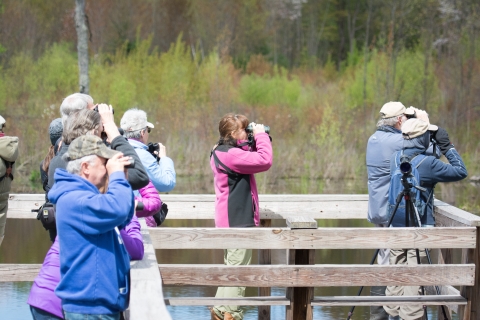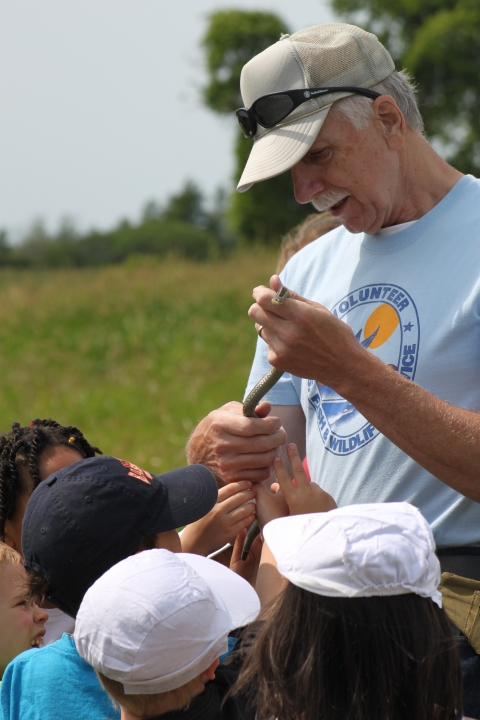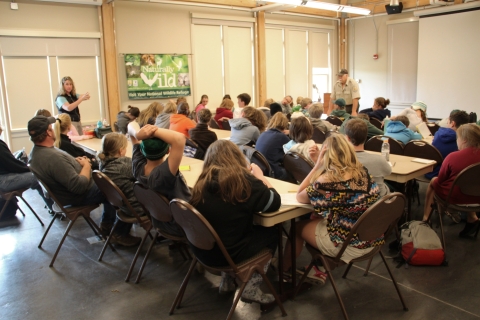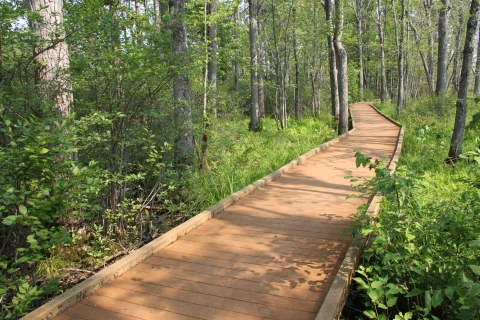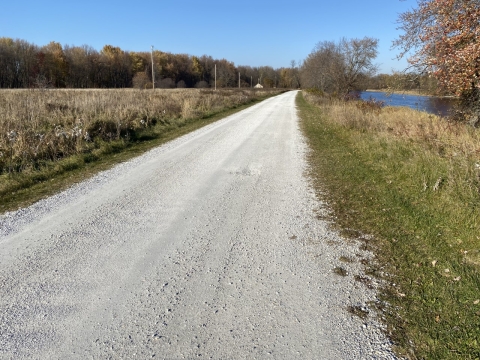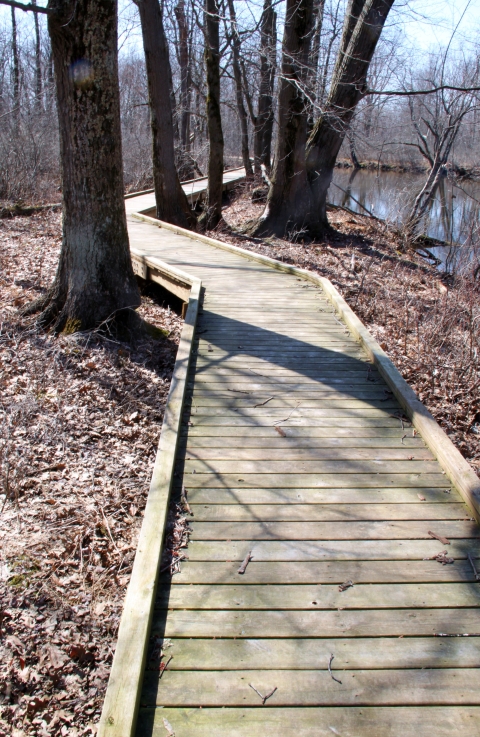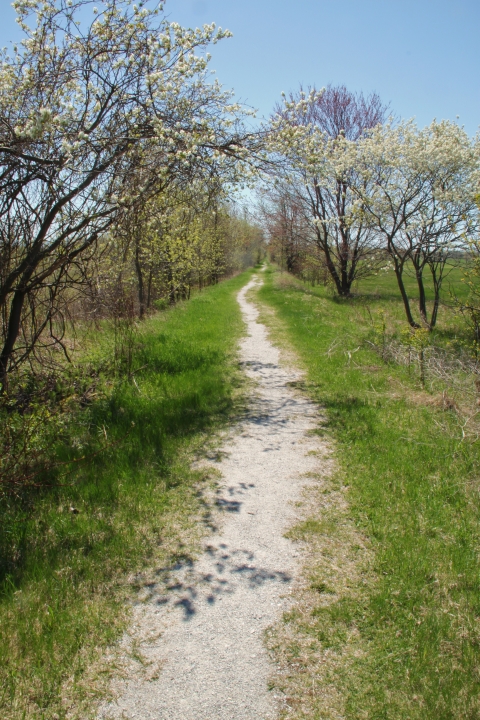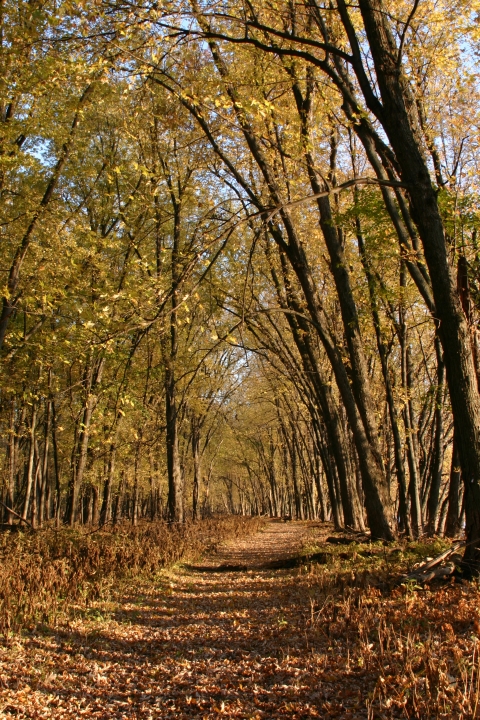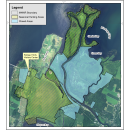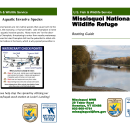Visit Us
The refuge is open for pedestrian trial use year-round from sunrise to sunset. We have a year round boat access area (Louie's Landing) and a seasonal boat ramp (Mac's Bend) for exploring the refuge on the Missisquoi River. Hunting and fishing are permitted during applicable state and refuge seasons and regulations.
The refuge has two other separate units: Westville and Eagle Point. The Westville Unit is located in the town of Westville, Franklin County, New York, approximately 10.5 miles north of the city of Malone. The Westville Unit consists of 262.4 acres and was acquired under provisions of the 1985 Farm Bill.
The Eagle Point Unit is located in the town of Derby, Vermont on the shore of Lake Memphremagog. In a unique partnership this unit is managed in cooperation with the Vermont Fish and Wildlife Department.
Activities
Hunting
Big game, upland small game, and water/other migratory bird hunting are allowed on portions of the refuge. Big game and upland small game both require an annual $10.00 permit. Waterfowl hunting is provided in both controlled hunt areas and public hunt areas. Controlled hunt zones may require a $10.00 permit during a portion of the waterfowl season, but public areas do not require a permit.
Youth waterfowl hunt opportunities are available at Missisquoi National Wildlife Refuge during the Vermont Youth Waterfowl Weekend and during the first 3 weekends of the regular waterfowl season.
Migratory Game Bird Hunting Map & Regulations (pdf)
Upland Game / Big Game Hunting (pdf)
2025 Controlled Waterfowl Hunt Dates
FISHING
The warm shallow water of the Missisquoi Delta provides excellent fishing opportunities on and around the refuge. Refuge boat launch facilities at Louie’s Landing and seasonally at Macs Bend allow boaters quick access to the river and Lake Champlain. Please be aware that some areas on the lake are closed to fishing. Paddling through flooded forest habitat along the river is prohibited during high water to reduce disturbance to migrating birds. Click here for a map of areas closed to boating and fishing access.
WILDLIFE VIEWING
Five refuge trails encompassing 7.5 miles provide excellent opportunities for wildlife observation in many different upland and wetland habitats. Numerous boardwalks on these trails allow quiet, elevated access through wildlife habitats to see migratory and resident species. The refuge delta, Missisquoi River, Dead Creek, provide a water rich alternative to observe wildlife on the refuge. Please note the Jeep Trail is open seasonally from August 1-April 1 only. This seasonal closure protects migratory birds and other wildlife during the breeding season. Kayaks, canoes, and small motorized boats allow access to the refuge in areas where trails are not available.
All trails are closed during the rifle and muzzleloader deer seasons with the exception of Black and Maquam Creek trail.
Refuge trails brochure (pdf)
Bird brochure (pdf)
Black Creek & Maquam Creek Nature Trails brochure (pdf)
INTERPRETATION
The refuge hosts annual events such International Migratory Bird Day on the third Saturday in May. This event is coupled with a refuge open house and art display featuring local artists and photographers. The Junior Waterfowl Hunter Training program is provided on the third Saturday in August. This activity provides expert instruction both indoors and outdoors for young waterfowlers age 12-17.
The first Saturday in May is Refuge green Up Day during which staff and volunteers conduct a cleanup of refuge waterways.
The Friends of Missisquoi NWR provide Monthly bird walks on the third Saturday of each month. Bog walks, Vernal Pool walks, Owl Prowls and other events occur seasonally during the year. Check the Friends of Missisquoi NWR's website for more information: https://friendsofmissisquoi.org/
Environmental Education
The Refuge HQ offers a large classroom for schools, summer camps, and other groups complete with audio/visual projection. Displays and exhibits are available in the HQ building as well. A hiking trail begins at the south entrance of the HQ building and offers educational opportunities to discuss green energy, macroinvertebrates, grassland habitats and a variety of other subject matter with students. The refuge provides outdoor classroom experiences to local schools and summer camps.
We invite you to explore and use Missisquoi National Wildlife Refuge as an outdoor classroom. Located near Swanton, we have 5 trails to discover, ponds for studying insects and water quality, as well as a modern visitor center with classroom facilities. There is no fee to use the refuge. We suggest education trips be conducted late May through early October. I
We have developed an Educator Guide to help you facilitate a trip to the refuge. You will find everything you need to guide your students though an immersive and hands on experience. We may also have a limited number of spaces for a staff-guided education programs. Please contact us to find out more. Additionally, education materials are available to borrow for use at the refuge or in your classroom.
Photography
Spring, summer and fall are the best times for photography at Missisquoi. These time periods provide opportunities to photograph both resident and migratory species. Winter wildlife most likely to be observed include pileated woodpeckers, whitetail deer, and chickadees. Spring and summer bring numerous migrants including a variety of waterfowl species, great blue herons, eagles and osprey, a variety of migrant songbirds are also present. Fall colors usher in returning concentrations of waterfowl as well as northern breeding songbirds as they move toward southern wintering areas. Photography from watercraft along the Missisquoi River and other adjacent water bodies is also productive in the spring, summer and fall.
Trails
Visit wildlife in their natural habitat as you explore the Missisquoi NWR trails. You are a guest in their home so please be respectful and follow trail guidelines. Trails are open to walking, snowshoeing, and xc skiing. During deer and waterfowl hunting season some trails will have advisories and closures. Call the refuge at (802) 868-4781 for the most up to date information.
Discovery Trail
1 mile (1.6 km) loop, 45 minutes
Starting at the Refuge Headquarters, follow this trail past ponds, through fields and into the woods. Walk along a gravel path, mowed trail, and boardwalks for an opportunity to see deer, red fox, coyote, songbirds and birds of prey.
Stephen J. Young Marsh Trail
1.25 mile (2 km) loop, 1 hour
Discover diverse habitats along this short path. Take in the colorful sights and distinctive smells of a freshwater wetland. Then head into the forest to look for owls, wood peckers and deer. Explore along a combination of gravel and mowed trail with elevated boardwalks.
Mac’s Bend Road
2 mile (3.2 km) round trip, 1.25 hours
Explore the rivers edge as you meander along this gravel road leading you deeper into the refuge. Keep watch for bald eagles and osprey that nest in the floodplain forest and great blue herons that stalk the rivers edge. This road opens to vehicles from September through December.
Black Creek & Maquam Creek Trails
2.5 miles ( 4 km) round trip, 1.5 hours
No hunting allowed on or near trail
Follow the mowed trail over the railroad tracks into a forest with boardwalks and gravel paths. Trails follow the creeks edge with chances to see beaver, muskrats, leopard frogs, and ducks. Birds song and hammering woodpeckers surrounds you on the walk.
Old Railroad Passage Trail
3 miles (4.8 km) round trip. 2 hours
Follow an old railroad bed through a meadow looking for bobolinks, field sparrows and meadowlarks Then pass through Maquam Bog—home to rare and unique plant species such as rhodera, pitch pine and the state threatened Virginia chain fern. The trail ends in a forest near Maquam Bay.
Jeep Trail
4 miles (6.5 km) round trip, 3 hours
(Open August 1—April 1)
Walk quietly along this mowed trail and you may see a deer, mink or osprey within the peaceful floodplain forest. Great blue herons wade along the shoreline looking to snack on fish, frogs, and tadpoles. A prime habitat for nesting birds, this trail is closed during the spring and early summer.
Trail Guidelines:
- Open sunrise to sunset
- Foot traffic only
- Stay on the path at all times
- Carry out your trash
- Plant and animal harvesting allowed by permit only
- Dogs allowed on a leash
Refuge Trail Card Challenge: walk all the trails on the refuge, take a photo of each location and get a free patch!. More information here.
Related Documents
The Missisquoi NWR has a variety of maps and fact sheets to help visitors explore the refuge. Since the refuge has areas which are managed as sanctuary units and are closed to the public it is important to review refuge maps, fact sheets and brochures before visiting the refuge. The refuge manages one unit in New York, the Westville Unit and co-manages another property with the Vermont Fish and Wildlife Department, the Eagle Point Unit. Each of these units have their own fact sheets detailing the public use activities and other regulations.
Rules and Policies
There are lots of fun, interesting, and educational things you can do on the refuge. Keep in mind, if an activity is not wildlife related and doesn’t help in the protection or understanding of wildlife or their habitat, there are probably refuge rules governing this activity. Please check with the refuge management before participating in an activity that could harm the environment or yourself. There are plenty of activities at Missisquoi NWR for you to enjoy. Be safe and have fun!




